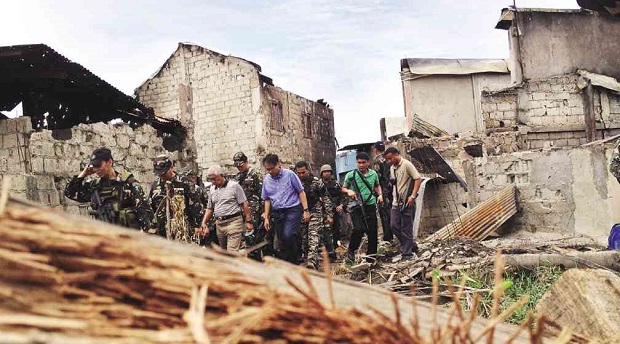
GOVERNMENT officials inspect a village in Zamboanga City ravaged by fighting between terrorists and government soldiers in September last year. JULIE S. ALIPALA/INQUIRER MINDANAO
ZAMBOANGA CITY— At least 60 survivors of the terror attack by followers of Moro leader Nur Misuari on this city did not survive diseases in evacuation centers that housed villagers displaced by weeks of fighting between the terrorists and government forces.
The city’s health office said those who died of diseases in shelters were mostly elderly people and children.
More than 100,000 residents were displaced by the terror attack on this city by members of the Moro National Liberation Front faction led by Misuari in September last year.
Misuari’s followers occupied the city and were driven away by force by government soldiers. At least 100 people, including civilians, were killed.
Dr. Rodelin Agbulos, city health chief, said on Thursday that the leading causes of deaths in the shelters were pneumonia and diarrhea.
Lea Ruth Gamboa, of the Philippine Red Cross, said that aside from pneumonia and diarrhea, other diseases like chicken pox, dengue and measles stalked the evacuees.
An evacuation center here continues to house more than 11,000 people who had not returned to their homes following the terror attack.
Agbulos said conditions inside the evacuation centers were the main contributors to the rise in diseases among evacuees.
“We are consolidating our reports but what I know is that there are more than 60 now,” he said, referring to the number of deaths.
Gamboa said many of the sick were not receiving proper medical attention because they could not afford it after the free hospitalization program of the city government ended.
“When someone gets sick, the family would immediately ask if it was free to send the patient to the hospital. If they were told it wouldn’t be, they would lose interest,” she said.
Gamboa said poor families got only discounts of up to 75 percent on hospital fees.
The Red Cross, she said, helps by providing evacuees nutritious food. Those who are frail and the elderly are separated from the rest of the evacuees in bunkhouses built by the International Organization for Migration.
Maria Socorro Rojas, of the Western Mindanao office of the Department of Social Welfare and Development (DSWD), said more than 20,000 people were still living in 10 evacuation centers and that the government was doing everything to help them.
Rojas said the DSWD had replaced its food ration with a food-for-work program.
But evacuees interviewed by the Inquirer said the food-for-work program was implemented only once.
“It wasn’t repeated and we are cash-strapped to even buy rice,” said Omar Mohammad, a 38-year-old father of two.
Omar said the 25 kilograms of rice that he got in December in exchange for sweeping streets for two weeks was now gone.
Aminah Mohadji, 35, also an evacuee, said her family’s rice ration of two cups was barely enough that she sent some of her children away. “I don’t want them to die of disease or hunger,” said Aminah.
Margani Suraji, caretaker of a makeshift morgue at Don Julian Rodriguez Memorial Complex, said the number of burials was increasing.
“Recently, the number of people being buried each week [has risen] to two,” Suraji said.
“We are basically on our own now, as the government has its hands full with [Supertyphoon “Yolanda”] victims these days,” he added. Julie Alipala, Inquirer Mindanao